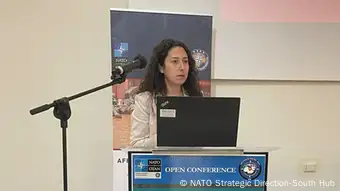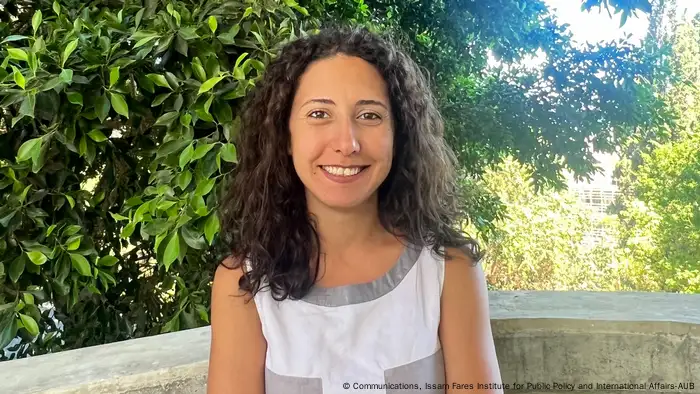Middle East/North Africa
Lebanese climate researcher Manale Abou Dagher aims to help journalists break down the science for readers and viewers
In Lebanon, environmental news often gets short shrift. The first climate science journalism course will teach young reporters to bring meaning and texture to a complex topic.
When she was in high school, Manale Abou Dagher joined an ecology club and soon found that it opened, well, the world to her. Later, at university, she studied geography and mapping, but her interest in ecology, and how it offered new approaches to so many problems, remained. In 2007, with a Masters Degree in environment and land management, she researched marine and coastal resources at a university in northern Lebanon and worked on studies, such as for Lebanon’s oil and gas sector. In 2021, Abou Dagher joined the Climate Change and Environment Program at the Issam Fares Institute for Public Policy and International Affairs at the American University of Beirut. Her professional interests and insight, especially in the holistic understanding of Lebanon’s environment, are now being put to broader use working with DW Akademie media trainers in preparing Lebanon’s first environmental journalism curriculum for young Lebanese journalists. In this interview, Abou Dagher describes how journalists can best explain the basic and applied science around climate change, with focus on governance and Lebanon’s environmental protection challenges.
Why climate science? What drew you to it exactly?
Basically, everything touches on climate change – water resources, conflict, pollution. I’m interested in translating the science to both policy makers and the average citizen. When I started my studies in geography, I found that the more I learned, I saw a bigger picture and that without studying the environment and how the climate is changing, it was hard to talk about issues like health, policies and the economy.
This helps explain your interest in helping develop the environmental journalism curriculum. What are the lessons about and what will the course look like?
The curriculum covers four weeks - two weeks of courses and two weeks in which the students must prepare their own story in a group of three to five participants. During the first week, I’ll introduce them to Lebanon’s four main issues: air pollution, land use and land cover change, solid waste and water and wastewater. I’ll teach them also how best to search for resources and experts in real-life situations. For example, during a forest fire, they should speak with local municipalities, NGO officers, the Ministry for the Environment, and field experts in order to understand the bigger picture and then write their story with a proper angle.
We’ll also have a session on environmental governance. In Lebanon, we have weak institutional and legal systems with outdated laws and decrees that are difficult to apply. Many public institutions are corrupt, there are conflicts of interest and mandates are unclear.

In November 2022, Abou Dagher was a panelist at a NATO conference on climate change and security in the Arab world.
It’s critical, too, for journalists to explain why a reader should care about the climate crisis. I liken it to a mother in her house who is understandably interested in namely caring for her children’s health and her family’s finances. She would probably not care if dolphins in the sea are dying because of pollution and climate change. But if you can relate climate change to health and economic crises, she would be interested – again the forest fire, and how forests purify the air would interest her more than telling her how many squirrels lost their habitats. So, I’ll be guiding the students through different ways to tell the same stories. We will also talk a lot about how to interpret data, such as in a graph, pie chart or table, and techniques for understanding scientific findings in a research paper.
What do you think of how the Lebanese press, or the press in general, is covering the environment now?
In Lebanon, there is so much going on now with political and economic crises, that the environment barely scores mention in the media.
Also, there is the problem of language. In Lebanon, articles and videos and news are all often written and posted in Arabic while almost all scientific research is published in either English or French. If you want to find a good data source, it will not be in Arabic. So, journalists have to translate findings into Arabic and then find the right terms to explain concepts, numbers and information.
Can you comment on Lebanon’s environmental policy record?
After the civil war in the early 1990s, the idea was to overcome the devastation, so the priority was on development and reconstruction projects. Many developmental projects were completed, such as reconstructing downtown Beirut. Few considered the environmental impacts. The Ministry for Environment was established in 1993, while Lebanon’s “Environmental Protection Act” passed in 2002. This law, however, requires application decrees, such as on Environmental Impact Assessments that were signed in 2014, 10 years later. Additionally, the Ministry’s budget is the lowest compared to all other Lebanese ministries.
What then are the most pressing climate stories journalists in Lebanon should cover?
As mentioned earlier, our studies showed that Lebanon’s four main environmental priorities are air pollution, land use and land cover change, solid waste, and water and wastewater. The challenge is to touch on these issues in a manner that is interesting for audiences. Therefore, we offer within this training directions to tackle such issues, like governance and management aspects, impacts on health, livelihood and societies. Why not set aside one page or one hour of radio or television time a week to run stories about climate change and the environment? If you think about it, there’s a sports section in the newspaper, a section for covering politics, the arts, business, local and regional news. But no environment sections. With these trainings, I’m hoping that learning the best approaches to telling the stories of climate change and threats to the environment – as well as solutions – will help young journalists help others understand why this is all so important and to not only report on events and disasters where nothing can be done.
DW recommends
- Date 21.02.2023
- Author Elizabeth Zach
- Feedback: Send us your feedback.
- Print Print this page
- Permalink https://p.dw.com/p/4NEJ4
- Date 21.02.2023
- Author Elizabeth Zach
- Send us your feedback.
- Print Print this page
- Permalink https://p.dw.com/p/4NEJ4

